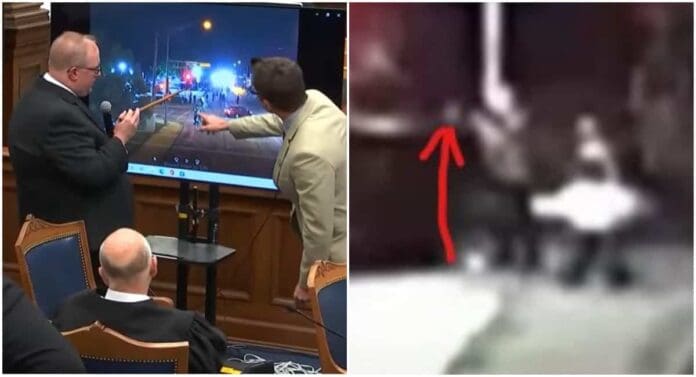Look where the red arrow is pointing. That’s NOT Rittenhouse’s hand. It can’t be, because the same blob is visible on video before Rittenhouse enters the frame.
Prosecutors finally pulled a rabbit out of a hat during jury instructions, getting the judge to let jurors decide whether Kyle Rittenhouse “provoked” Joseph Rosenbaum by pointing a gun at another man first, but it’s an absurd argument that’s based on a couple of exceptionally blurry and very misleading photos and videos.
Analysis of the prosecutor’s photo and video “evidence” actually provides counter-evidence that Rittenhouse wasn’t pointing the rifle at all. Minimally, there’s reasonable doubt.
Even the judge had trouble deciphering what the state wanted him to look at. “I certainly can’t give a provocation instruction based on a picture I can’t make anything out of,” Judge Bruce Schroeder said at one point.
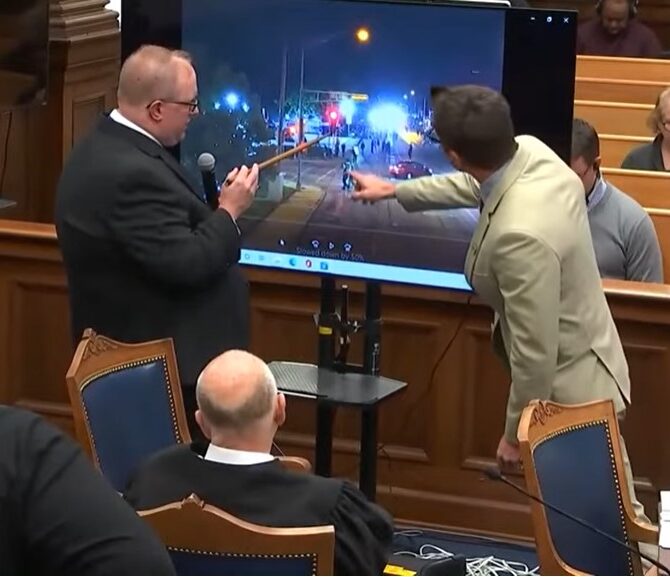
How desperate are prosecutors? They’re so desperate that they’re arguing the jury should find that Kyle Rittenhouse provoked Joseph Rosenbaum to chase Rittenhouse down and reach for his gun because they claim Rittenhouse pointed his rifle at another man, Joshua Ziminski, first. Ziminski was armed and allegedly vandalizing cars. He also, Rittenhouse testified, had yelled, “get him and kill him” right before Rosenbaum gave chase.
But the screenshot of one fuzzy photo they want to show jurors is deceptive, and we will explain how below.
In other words, prosecutors are arguing that Rosenbaum had the right to chase Rittenhouse down and kill him because they say he briefly pointed a gun at Ziminski, and that Rittenhouse thus forfeited the right to self-defense. But that’s absurd for a multitude of reasons, among them the fact that Rittenhouse was RUNNING AWAY from Rosenbaum.
If the jury buys the state’s ridiculous provocation argument, it doesn’t eliminate Rittenhouse’s ability to claim self-defense. It does add extra hurdles to it, though, as Rittenhouse would need to also show that he 1) exhausted all available avenues for withdrawal and 2) gave Rosenbaum “adequate notice” that he was withdrawing from the encounter. Still, the fact that Judge Bruce Schroeder is even allowing the jury to CONSIDER provocation is a win for the prosecution.
The concern for the defense is: if there is a juror who just wants to convict, despite the strength of the self-defense claims, will this be the legal life raft they grab onto?
Rittenhouse was running away and only stopped when Rosenbaum had cornered him by cars. Another drone video shows a large number of people were rioting and smashing cars on the other side of those vehicles. The prosecution argues he still had an avenue to escape, but we’re not sure running head-on into a large crowd of active vandals counts. As for notice, isn’t running away notice enough? The prosecution argues he turned back and pointed his weapon at Rosenbaum, but that was because Rosenbaum was chasing him and gaining speed.
Here’s why the state’s argument that Rittenhouse was the provocateur is absurd:
Provocation Debunked
The Prosecution’s Photo Is Incredibly Blurry
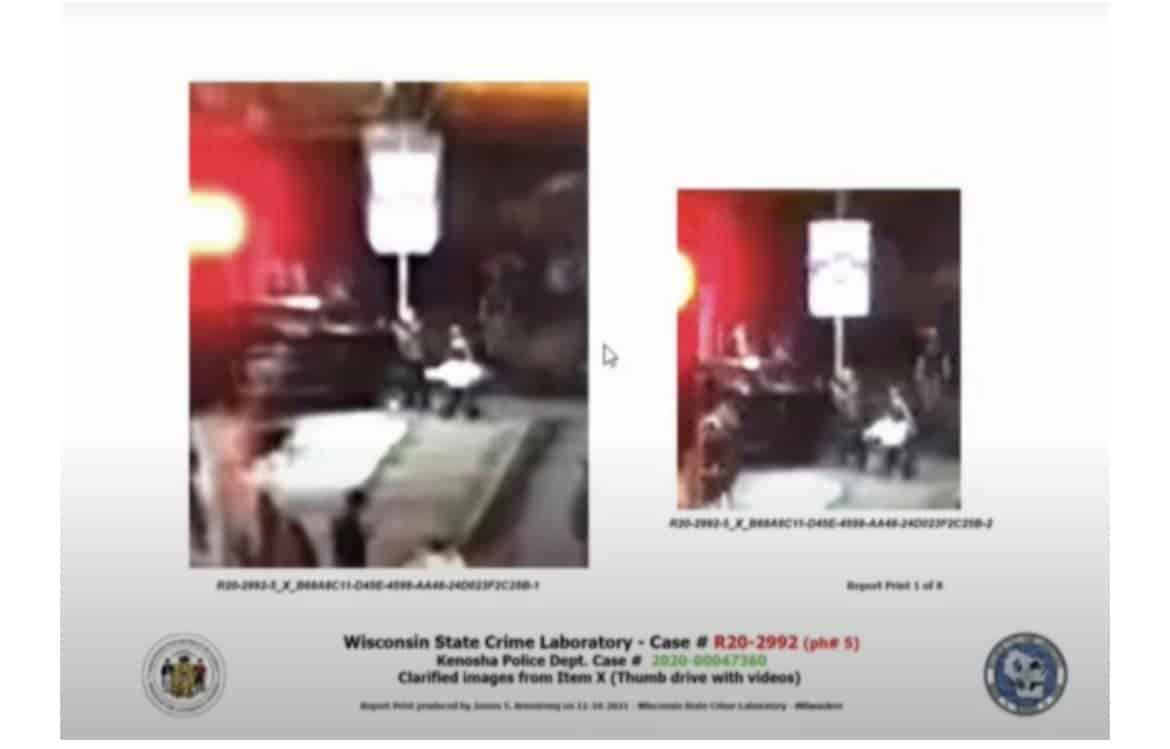
Upon closer scrutiny, the photos and videos don’t prove Rittenhouse pointed the gun at all. They are, frankly, too blurry to tell anything for sure, but they do provide several clues that go against the state’s theory. If you don’t believe us, look at the above photos and tell us what YOU see.
For one, the blurry photo, which prosecutors claim shows Rittenhouse lifting the rifle, shows what prosecutors claim is Rittenhouse’s raised arm on the wrong side for him to be carrying the rifle in it (he’s not left-handed, and the supposed raised arm is on his left-hand side. He was carrying the rifle in a sling).
Even if he DID point the gun at Ziminski, which is entirely not proven by the prosecution’s flimsy and misleading “evidence,” how does that provoke ROSENBAUM, who, testimony showed, didn’t even know Ziminski?
You can’t even see Ziminski in that photo at all. Defense attorney Corey Chirafisi said the defense believes the photo “shows the side mirror of the Duramax (a vehicle) and part of the strap from his sling” and no pointing. He also pointed out that Rittenhouse was captured saying, “friendly, friendly, friendly,” on video around the same time.
It is, in short, ridiculous. It is, minimally, reasonable doubt on provocation.
Even the judge couldn’t figure out what was in the blurriest photo the state is trying to use.
Why did the judge allow the provocation instruction then? “It’s the jury’s case; I think they should make the critical decisions,” Schroeder said in court Friday.
The judge, who scrutinized the photos and videos before making his decision to allow the provocation instruction, said at one point, “What am I looking at?”
The White Blob in the Blurry Photo Is NOT Rittenhouse’s Hand, Video Shows
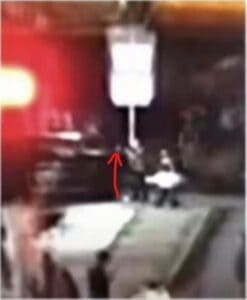
Analysis shows the white blur which the above prosecution exhibit seems to show as Rittenhouse’s raised left hand, making it possibly look like he’s pointing a gun, is actually present prior to Rittenhouse entering the scene.
Got that? Look where the red arrow is pointing. That’s NOT Rittenhouse’s hand. It can’t be, because the same blob is visible on video before Rittenhouse enters the frame.
That’s deceptive. The prosecutors want to present a screenshot of a video frame that includes the white blob. But it can’t be Rittenhouse’s hand when you watch the video. It just falsely LOOKS LIKE IT in the state’s screenshot.
Here’s an excellent video analysis that shows this point:
NEW ANALYSIS: Image purporting to be #KyleRittenhouse aiming his rifle, is a single frame still. Algorithmically introduced artifacts & pixelation aside, the image is simply NOT showing what the DA claims it does.
Kyle is not lefty
Kyle’s support hand exists prior to his entry pic.twitter.com/UpGPa3g8ZZ
— D a r t h C r y p t o (Can't Keep me Down!) (@DefNotDarth) November 12, 2021
The state crime lab analyst who enhanced the photo “took 20 hours to manipulate that photo to get that blurry mess up on the screen,” defense attorney Mark Richards claimed. He said their own expert countered it, showing it wasn’t Rittenhouse pointing a rifle.
The judge said, “I’m not even going to tell you what I saw in it.”
The prosecution claims if Rittenhouse provoked Rosenbaum, then the other shootings were provoked by that provocation, basically. In other words, it all rolls downhill.
But wait – didn’t Gaige Grosskreutz provoke Rittenhouse to shoot him then by advancing toward him while pointing a gun at him from about three feet away? Didn’t Anthony Huber provoke Rittenhouse to shoot him by rushing him, hitting him with a skateboard, and trying to grab his gun? Didn’t Jump Kick man provoke him by rushing him, jumping over him and delivering a kick to his head?
The Drone Video Is Debunked By an Infrared Video
Prosecutor Jim Kraus took pains to stress to the judge that the state is not ONLY relying on the blurry photo to argue provocation. They also have a drone video. They have a detective testifying about what he saw in the materials.
The drone video cited by the prosecution isn’t much better, though. Again, they claim it shows Rittenhouse pointing a gun at Ziminski.
However, an astute analysis of it online compared the drone video with the separate FBI infrared video that glows based on body heat and argues that Rittenhouse pointed at Ziminski with his arm, but not the arm/hand that was carrying the rifle. You can tell because the arm is glowing, and a rifle would not glow in an infrared video, because it didn’t have body heat. The writer raises another good point: Why did the FBI sit on its infrared video for so long?
BREAKING: FBI infrared video proves Kyle’s arm is pointing at Ziminskis, not rifle. Binger lied.
Rifles are not the same temperature as a human body
Now we know why the FBI withheld this evidence for 14 months pic.twitter.com/D2h7qjtfPx
— Jacek Posobiec 🇺🇸🇵🇱 (@JackPosobiec) November 12, 2021
The video also allegedly shows Ziminski with a gun in his hand.
Even the prosecution alleges Ziminski was engaged in active vandalism at the time. He’s the guy Rittenhouse claims said, “get him and kill him” right before Rosenbaum chased him. Is that the moment he said that? Ziminski also fired his gun in the air a short time later and before Rittenhouse shot Rosenbaum, both legal teams say.
Foreshadowing what prosecutors will say in their closing arguments, Kraus said, “We are saying in the incident of Rosenbaum, he (Rittenhouse) provoked it by raising his rifle and pointing it at individuals.
It’s why Rosenbaum gave chase to him. The defendant had a duty to retreat; he retreated, but instead of giving notice of his withdrawal from the fight, he pointed his gun again and that continued. It is not his mere presence. We will argue the video evidence contrary to the defendant’s testimony shows he raised his weapon at individuals and that is what provoked the attack.” The individuals were Ziminski and his wife.
The Blurry Defense Exhibit
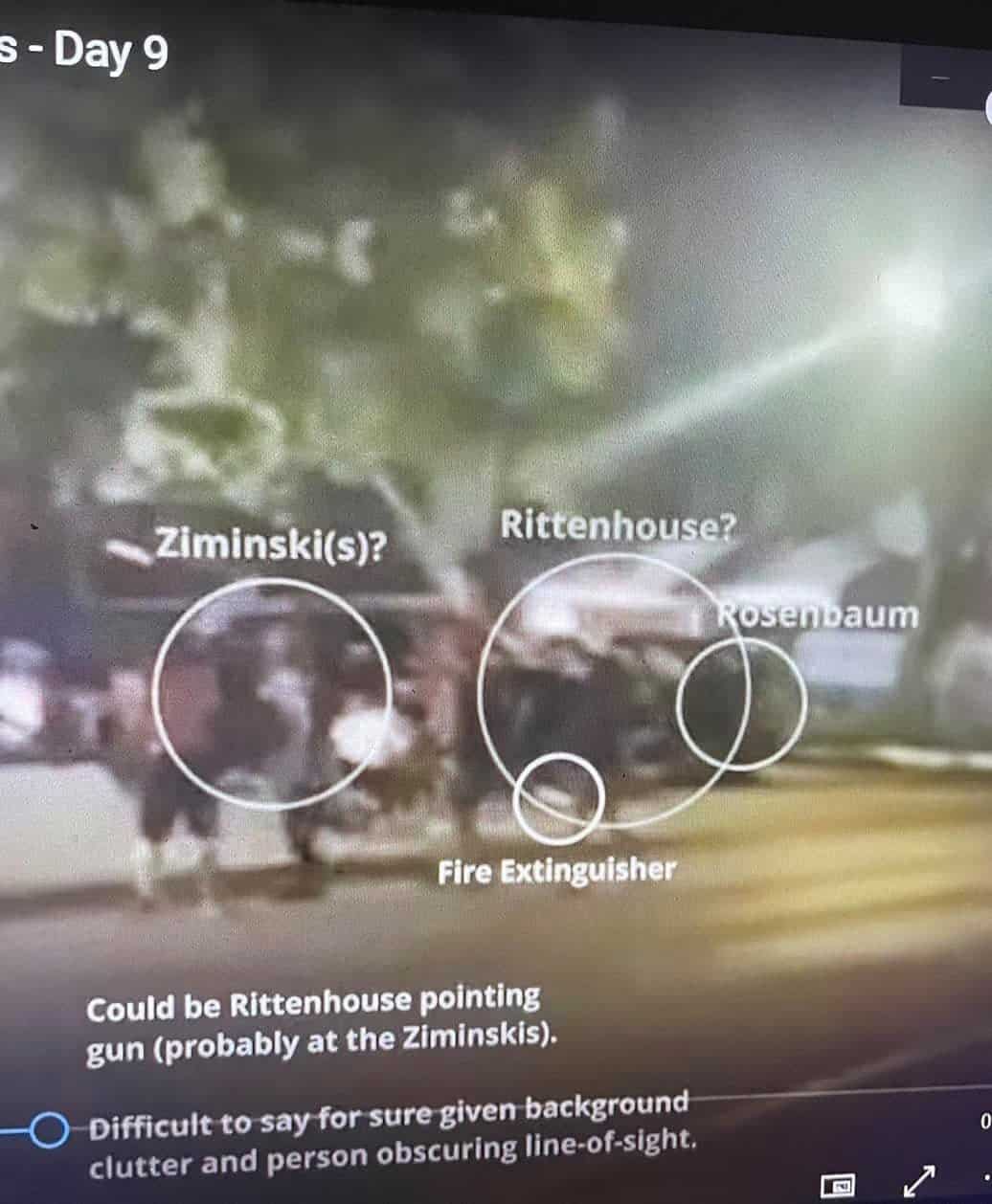
The prosecution also presented a defense exhibit, claiming it shows Rittenhouse pointing a rifle at Ziminski. It’s unclear too, though. Was he pointing the hand without the gun? Is he pointing at all?
“I don’t think that photo shows anything,” Chirafisi said.
“That’s up to the jury,” said Judge Schroeder.
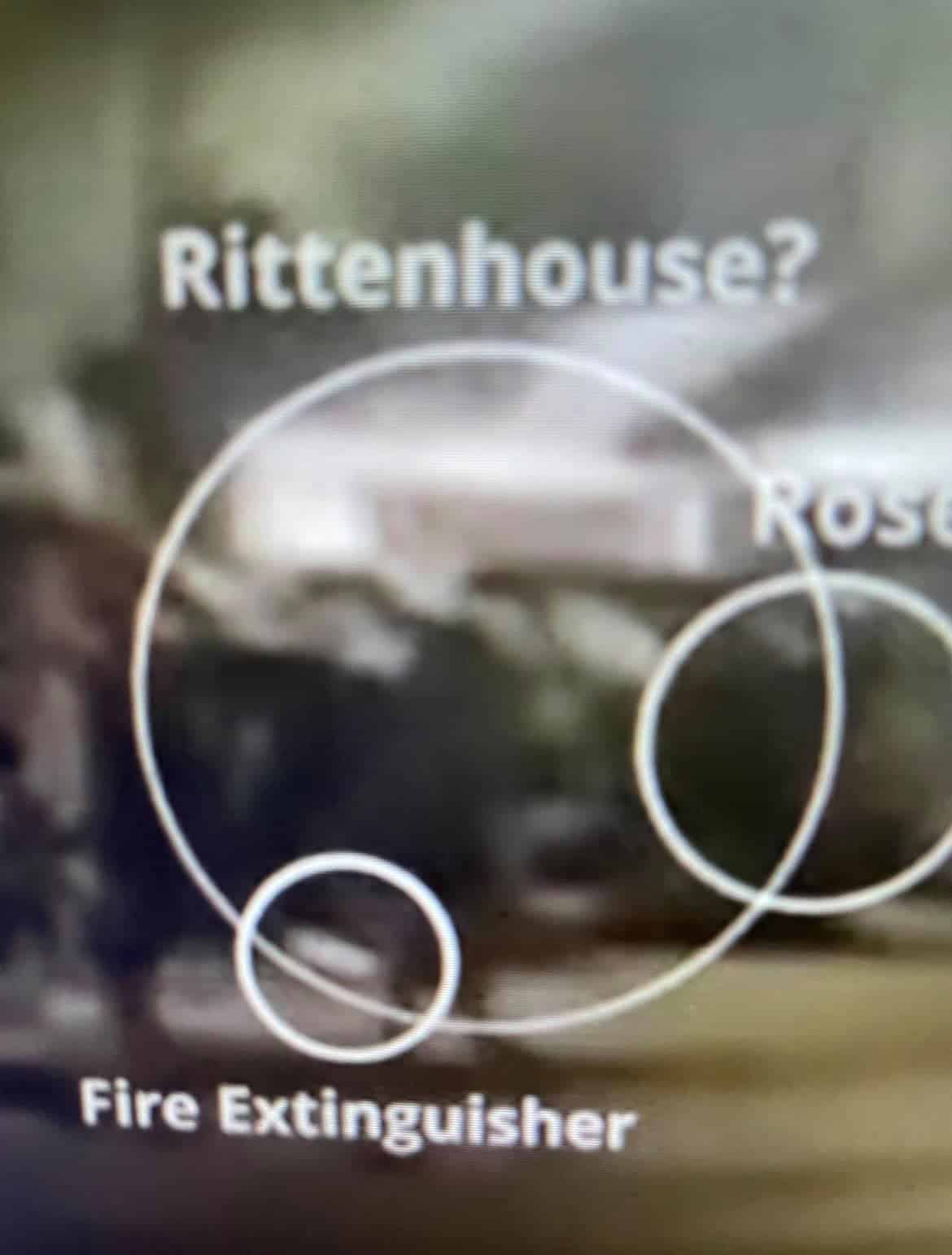
Even weirder, prosecutors never called Ziminski to the stand (he’s facing serious charges, including for arson). Surely, if Rittenhouse pointed his gun at Ziminski (which could have been another act of self-defense if he did because of the armed Ziminski’s comment and actions), then Ziminski could have best testified to that? But, no, the prosecution wants jurors to interpret blurry videos and photos instead.
What is Provocation?
The provocation statute really applies to other situations best, such as, for example, an armed robber who bursts into a store with a gun and then shoots the store owner behind the counter who raises a gun against him in defense. But that’s not what happened here.
The prosecution admits they are not arguing, by the way, that Rittenhouse, just by virtue of having the gun, provoked Rosenbaum. They have to show more. They have to show that he did something with the gun to provoke him. Hence, they are arguing he pointed it at Ziminski first, prompting Rosenbaum to give chase.
Defense attorney Mark Richards added, “How does pointing a gun at Ziminski provoke Rosenbaum who they say didn’t know each other?” But the defense denies he pointed the gun.
The judge asked, “Rosenbaum twice before threatened to kill the accused; what is the legal effect of a person if he made such a threat, what legal justification does he have to chase after the accused, to put the defendant into the position to be a provocateur?”
Prosecutor Jim Kraus said the state is not accepting that those threats occurred despite witness testimony. “Mr. Rosenbaum does not give up the ability to be provoked because he may have said things an hour earlier,” Kraus said, calling the state’s provocation claims a “great argument.” He said the state believes Rittenhouse pointed the gun at Ziminski for a “property crime” because Ziminski was probably vandalizing cars.
According to Chirafisi, the state crime lab analyst who enhanced the blurry photo “couldn’t really answer a lot of questions” about pixels and colors in the photo caused by blowing it up. “Rosenbaum threatened to kill, he yelled gun, gun, gun, he’s chasing him (Rittenhouse) down, he yells ‘f***’ you before this happens,” Chirafisi said, denying that Rittenhouse provoked Rosenbaum.
Rittenhouse and other witnesses testified Rosenbaum made threats to kill Rittenhouse and others earlier in the night. He was upset because Rittenhouse had a fire extinguisher and was trying to put out arson fires. Both Ziminski and Rosenbaum are accused of being involved in that.
What is provocation under the law? Here are the typical jury instructions on it (Rittenhouse’s jury instructions will be released after 4 p.m. Sunday).
815 PRIVILEGE: SELF-DEFENSE: NOT AVAILABLE TO ONE WHO PROVOKES AN ATTACK: REGAINING THE PRIVILEGE — § 939.48(2)
[ADD THE FOLLOWING TO WIS JI‑CRIMINAL 800, 801, OR 805 WHEN SUPPORTED BY THE EVIDENCE.]
Provocation
You should also consider whether the defendant provoked the attack. A person who engages in unlawful conduct[1] of a type likely to provoke others to attack, and who does provoke an attack, is not allowed to use or threaten force in self‑defense against that attack.
[USE ANY OF THE FOLLOWING PARAGRAPHS THAT ARE SUPPORTED BY THE EVIDENCE.]
[However, if the attack which follows causes the person reasonably to believe that he or she is in imminent danger of death or great bodily harm, he or she may lawfully act in self‑defense. But the person may not use or threaten force intended or likely to cause death unless he or she reasonably believes he or she has exhausted every other reasonable means to escape from or otherwise avoid death or great bodily harm.]
[A person who provokes an attack may regain the right to use or threaten force if the person in good faith withdraws from the fight and gives adequate notice of the withdrawal to his assailant.]
[A person who provokes an attack whether by lawful or unlawful conduct with intent to use such an attack as an excuse to cause death or great bodily harm to another person is not entitled to use or threaten force in self‑defense.]
COMMENT
Wis JI‑Criminal 815 was originally published in 1962 and revised in 1994 and 1999. The 1999 revision updated the comment. This revision amended the language of the instruction to more accurately reflect the language of Wis. Stat. 939.48(2)(a) and was approved by the Committee in July 2019.
The 1962 version of Wis JI‑Criminal 815 was cited as a correct statement of the law in State v. Walker, 99 Wis.2d 687, 695‑96, 299 N.W.2d 861 (1981). It was reviewed again in State v. Herriges, 155 Wis.2d 297, 455 N.W.2d 635 (Ct. App. 1990). The court held that a person who provokes an attack must retreat in order to regain the privilege of self‑defense, even if that person is in his own home:
. . . . The home provides a haven, not an arena. “One assaulted in his house need not flee therefrom. But his house is his castle only for the purposes of defense. It cannot be turned into an arsenal for the purposes of offensive effort against the lives of others. It is a shelter, but not a sally-port.” Raines v. State, 445 So.2d 967, 972 (Ala. Crim. App. 1984). We therefore follow the direction given by our supreme court in Miller and adopt the rule that if there has been provocation by the one assaulted, even if that provocation occurs in the home, successful assertion of self-defense requires a reasonable belief that one cannot retreat before force likely to cause death or great bodily harm may be used.
155 Wis.2d 297, 304‑05.
The “duty to retreat” is extensively discussed in Wis JI‑Criminal 810.
[1]. The first paragraph of the instruction reflects the rule stated in sub. (2) of § 939.48, which provides that a “person who engages in unlawful conduct of a type likely to provoke others . . .” loses the right to claim the privilege of self-defense. In State v. Boughneit, 97 Wis.2d 687, 294 N.W.2d 675 (Ct. App. 1980), the court held that engaging in what would be considered disorderly conduct under § 947.01 would constitute “unlawful conduct” for the purposes of § 939.48(2)


